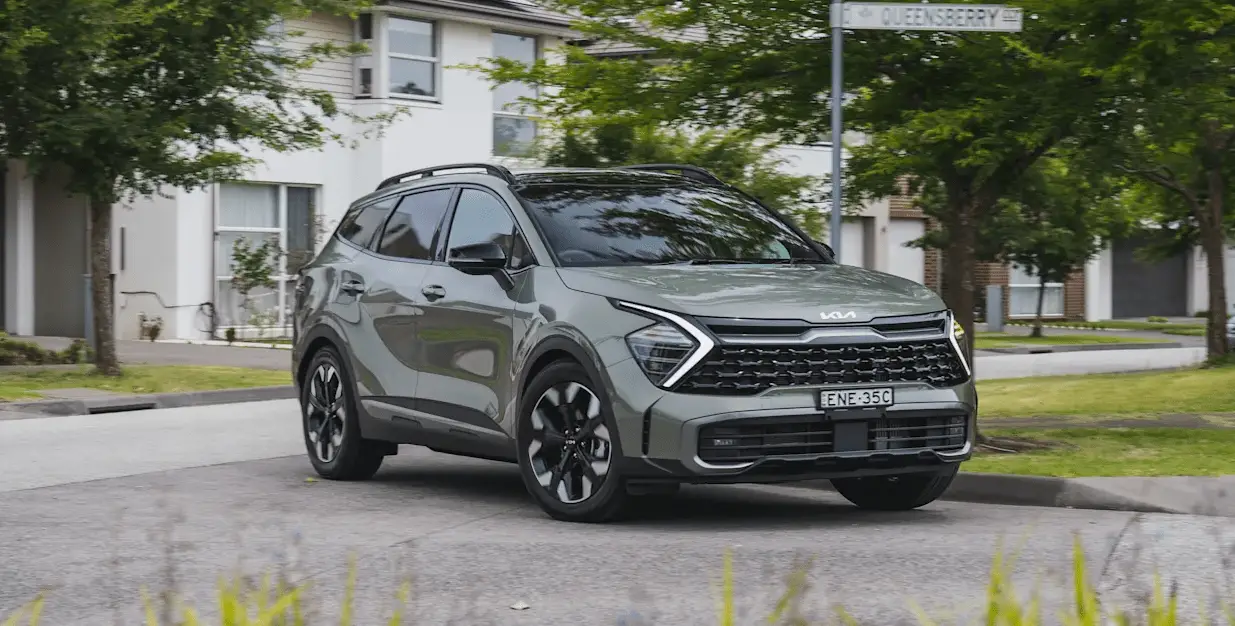2022 Kia Sportage Your Vehicle At a Glance Introduction
HOW TO USE THIS MANUAL
We want to help you get the greatest possible driving pleasure from your vehicle. Your Owner’s Manual can assist you in many ways. We strong-ly recommend that you read the entire manual. In order to minimize the chance of death or injury, you must read the WARNING and CAUTION sections in the manual.
Illustrations complement the words in this manual to best explain how to enjoy your vehicle. By reading your manual, you will learn about features, important safety information, and driving tips under various road conditions.
The general layout of the manual is provided in the Table of Contents. Use the index when looking for a specific area or subject; it has an alphabetical listing of all information in your manual.
Sections: This manual has nine sections plus an index. Each section begins with a brief list of contents so you can tell at a glance if that section has the information you want.
You will find various WARNINGs, CAUTIONs, and NOTICEs in this manual. These WARNINGs were pre-pared to enhance your personal safety. You should carefully read and follow ALL procedures and recommendations provided in these WARNINGs, CAUTIONs and NOTICEs.
2023 KIA SPORTAGE Specs, Price, Features, Mileage and Torque
WARNING
A WARNING indicates a situation in which harm, serious bod-ily injury or death could result if the warning is ignored.
CAUTION
A CAUTION indicates a situation in which damage to your vehicle could result if the caution is
ignored.
NOTICE
A NOTICE indicates interesting or helpful information is being provided.
FUEL REQUIREMENTS
Your new vehicle is designed to use only unleaded fuel having a pump octane number ((R+M)/2) of 87 (Research Octane Number 91) or higher. (Do not use methanol blended fuels.)
Your new vehicle is designed to obtain maximum performance with UNLEADED FUEL, as well as mini-mize exhaust emissions and spark plug fouling.
Never add any fuel system cleaning agents to the fuel tank other than what has been specified. (Consult an authorized Kia dealer for details.)
- Tighten the cap until it clicks one time, otherwise the Check Engine light will illuminate.
WARNING Refueling
- Do not “top off” after the nozzle automatically shuts off. Attempts to force more fuel into the tank can cause fuel overflow onto you and the ground causing a risk of fire.
- Always check that the fuel cap is installed securely to prevent fuel spillage, especially in the event of an accident.
Pursuant to EPA regulations, ethanol may be used in your vehicle.
Do not use gasohol containing more than 15% ethanol, and do not use gasoline or gasohol containing any methanol. Ethanol provides less energy than gasoline and it attracts water, and it is thus likely to reduce your fuel efficiency and could lower your MPG results.
Methanol may cause drivability prob-lems and damage to the fuel system, engine control system and emission control system.
Discontinue using gasohol of any kind if drivability problems occur.
Vehicle damage or drivability problems may not be covered by the manufacturer’s warranty if they result from the use of:
- Gasoline or gasohol containing methanol.
- Leaded fuel or leaded gasohol.
- Gasohol containing more than 15% ethanol.
“E85” fuel is an alternative fuel comprised of 85 percent ethanol and 15 percent gasoline, and is manufactured exclusively for use in Flexible Fuel Vehicles. “E85” is not compatible with your vehicle. Use of “E85” may result in poor engine performance and damage to your vehicle’s engine and fuel system. Kia recom-mends that customers do not use fuel with an ethanol content exceed-ing 15%.
NOTICE
Your New Vehicle Limited Warranty does not cover damage to the fuel system or any performance problems caused by the use of “E85” fuel.
NOTICE
Never use any fuel containing methanol. Discontinue use of any methanol containing product which may inhibit proper drivability.
Other fuels
Using fuels that contain Silicone (Si), MMT (Manganese, Mn), Ferrocene (Fe), and Other metallic additives, may cause vehicle and engine dam-age or cause misfiring, poor acceleration, engine stalling, catalyst melt-ing, clogging, abnormal corrosion, life cycle reduction, etc.
Also, the Malfunction Indicator Lamp (MIL) may illuminate.
NOTICE
Damage to the fuel system or performance problem caused by the use of these fuels may not be covered by your New Vehicle Limited Warranty.
Gasoline containing MMT
Some gasoline contains harmful manganese-based fuel additives Such as MMT(Methylcyclopentadienyl Manganese Tricarbonyl). Kia does not recommend the use of gasoline containing MMT. This type of fuel can reduce vehicle performance and affect your emission control system. The Malfunction Indicator Lamp on the cluster may come on.
Do not use methanol
Fuels containing methanol (wood alcohol) should not be used in your vehicle. This type of fuel can reduce vehicle performance and damage components of the fuel system, engine control system and emission control system.
Fuel Additives
Kia recommends that you use good quality gasolines treated with deter-gent additives such as TOP TIER Detergent Gasoline, which help pre-vent deposit formation in the engine. These gasolines will help the engine run cleaner and enhance performance of the Emission Control System. For more information on TOP TIER Detergent Gasoline, please go to the website www.toptiergas.com
For customers who do not use TOP TIER Detergent Gasoline regularly, and have problems starting or the engine does not run smoothly, addi-tives that you can buy separately may be added to the gasoline.
If TOP TIER Detergent Gasoline is not available, one bottle of additive should be added to the fuel tank at every 7,500 miles or every engine oil change is recommended. Additives are available from your authorized Kia dealer along with information on how to use them. Do not mix other additives.
Operation in foreign countries
If you are going to drive your vehicle in another country, be sure to:
- Observe all regulations regarding registration and insurance.
- Determine that acceptable fuel is available.
VEHICLE HANDLING INSTRUCTIONS
As with other vehicles of this type, failure to operate this vehicle correct-ly may result in loss of control, an accident or vehicle rollover.
Specific design characteristics (higher ground clearance, track, etc.) give this vehicle a higher center of gravity than other types of vehicles. In other words they are not designed for cornering at the same speeds as conventional 2-wheel drive vehicles. Avoid sharp turns or abrupt maneuvers. Again, failure to operate this vehicle correctly may result in loss of control, an accident or vehicle rollover. Be sure to read the “Reducing the risk of a rollover” driving guidelines, in chapter 6 of this manual.
VEHICLE MODIFICATIONS
This vehicle should not be modified. Modification of your vehicle could affect its performance, safety or durability and may even violate governmental safety and emissions regulations.
In addition, damage or performance problems resulting from any modification may not be covered under warranty.
- If you use unauthorized electronic devices, it may cause the vehicle to operate abnormally, wire damage, battery discharge and fire. For your safety, do not use unauthorized electronic devices.
VEHICLE BREAK-IN PROCESS
No special break-in period is need-ed. By following a few simple precautions for the first 600 miles (1,000 km) you may add to the performance, economy and life of your vehicle.
- Do not race the engine.
- While driving, keep your engine speed (rpm, or revolutions per minute) between 2,000 rpm and 4,000 rpm.
- Do not maintain a single speed for long periods of time, either fast or slow. Varying engine speed is needed to properly break-in the engine.
- Avoid hard stops, except in emergencies, to allow the brakes to seat properly.
- Don’t tow a trailer during the first 1,200 miles (2,000 km) of operation.
VEHICLE DATA COLLECTION AND EVENT DATA RECORDERS
This vehicle is equipped with an event data recorder (EDR). The main purpose of an EDR is to record, in certain crash or near crash-like situations, such as an air bag deployment or hitting a road obstacle, data that will assist in understanding how a vehicle’s systems performed. The EDR is designed to record data related to vehicle dynamics and safety systems for a short period of time, typically 30 seconds or less. The EDR in this vehicle is designed to record such data as:
- How various systems in your vehicle were operating;
- Whether or not the driver and passenger safety belts were buckled/fastened;
- How far (if at all) the driver was depressing the accelerator and/or brake pedal; and,
- How fast the vehicle was traveling.
These data can help provide a better understanding of the circum-stances in which crashes and injuries occur. NOTE: EDR data are recorded by your vehicle only if a non-trivial crash situation occurs; no data are recorded by the EDR under normal driving conditions and no personal data (e.g., name, gender, age, and crash location) are recorded. However, other parties, such as law enforcement, could combine the EDR data with the type of personally identifying data routinely acquired during a crash investigation.
To read data recorded by an EDR, special equipment is required, and access to the vehicle or the EDR is needed. In addition to the vehicle manufacturer, other parties, such as law enforcement, that have the special equipment, can read the information if they have access to the vehicle or the EDR.
Kia Sportage 2022 Your Vehicle at a Glance
Exterior overview
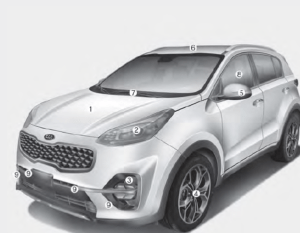
- Hood………………………………………………4-46
- Head lamp (Features of your vehicle) …4-127
Head lamp (Maintenance)…………………7-81 - Front fog lamp
(Features of your vehicle)…………………4-133
Front fog lamp (Maintenance) ……………7-81 - Wheel and tire…………………………..7-46, 8-5
- Outside rearview mirror…………………….4-76
- Panoramic sunroof …………………………..4-52
- Front windshield wiper blades
(Features of your vehicle)………………..4-135
Front windshield wiper blades
(Maintenance) …………………………………7-41 - Windows…………………………………………4-41
- Front ultrasonic sensor……………………4-122
The actual shape may differ from the illustration.
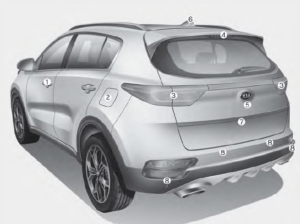
- Door locks ………………………………………4-23
- Fuel filler door …………………………………4-48
- Rear combination lamp (Maintenance) ..7-82
- High mounted stop lamp (Maintenance)…7-82
- Liftgate …………………………………..4-28, 4-31
- Antenna………………………………………..4-190
- Rear view camera ………………………….4-117
- Rear ultrasonic sensor………….4-118, 4-122
INTERIOR OVERVIEW

- Inside door handle……………………………..4-24
- Power window switch………………………….4-42
- Central door lock switch ……………………..4-25
- Power window lock button …………………..4-45
- Outside rearview mirror control ……………4-77
- Outside rearview mirror folding ……………4-78
- Instrument panel illumination control ……4-81
- Blind-Spot Safety button……………………5-100
- Lane Safety button……………………………..5-92
- Power liftgate open/close button ………..4-31
- Steering wheel…………………………………4-58
- Tilt and telescopic steering control
lever………………………………………………..4-59 - Inner fuse panel……………………………….7-63
- Brake pedal……………………………………..5-35
- Parking brake pedal………………………….5-33
- Hood release lever……………………………4-46
- Seat………………………………………………….3-4
INSTRUMENT PANEL OVERVIEW
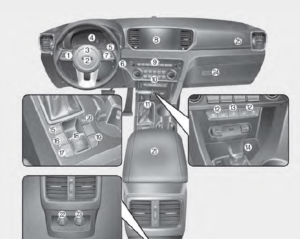
- Steering wheel audio controls ………..4-190
- Driver`s front air bag ………………………3-60
- Horn……………………………………………..4-61
- Instrument cluster…………………………..4-80
- Wiper and washer control lever………4-135
- Ignition switch………………………………….5-7
ENGIN START/STOP button ……………5-11 - Cruise control ………………………………5-114
- Audio ………………………………………….4-190
- Hazard warning flasher …………………….6-2
- Manual climate control system……..4-144
Automatic climate control system….4-155 - Shift lever A/T………………………………5-15
- Seat warmer………………………………4-177
Air ventilation seat ………………………4-178 - Heated steering wheel button ………..4-60
- Smart phone wireless charger ……..4-181
- Drive mode button ………………………..5-57
- AWD Lock button………………………….5-23
- DBC button………………………………….5-51
- Electronic Parking Brake (EPB) switch .5-34
- Auto Hold On/Off button ………………..5-41
- Parking Safety button………………………4-122
- Center console storage box …………4-173
- USB charger………………………………4-180
- Power outlet……………………………….4-179
- Glove box ………………………………….4-173
The actual shape may differ from the illustration.
ENGINE COMPARTMENT
- Gasoline engine (Theta II 2.4L GDI
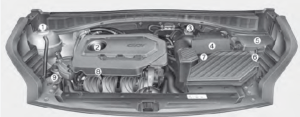
- Gasoline engine (Theta II 2.0L T-GDI)
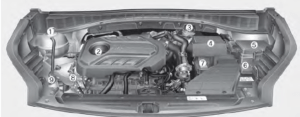
- Engine coolant reservoir ……………….7-30
- Engine oil filler cap ………………………7-27
- Brake fluid reservoir……………………..7-33
- Air cleaner…………………………………..7-36
- Fuse box …………………………………….7-65
- Negative battery terminal………………7-43
- Positive battery terminal ……………….7-43
- Engine oil dipstick ………………………..7-27
- Windshield washer fluid reservoir …..7-34
The actual engine room in the vehicle may differ from the illustration.
FAQs
The Kia Sportage 2022 is a compact crossover SUV. It falls into the SUV category, specifically the compact SUV segment.
The Kia Sportage 2022 typically seats five passengers in its two rows of seating.
The available trim levels may vary depending on your region and market, but common trims often include LX, S, EX, and SX. Higher trims may offer more advanced features and options.
The Kia Sportage 2022 may offer different engine options, including four-cylinder engines with varying power outputs and, in some markets, hybrid or electric powertrains.
The standard transmission for the Kia Sportage 2022 is typically an automatic transmission, though manual transmissions may be available in some markets.
The Kia Sportage 2022 is often available with both front-wheel drive (FWD) and all-wheel drive (AWD) configurations, allowing you to choose the drivetrain that suits your needs.
The Kia Sportage 2022 may offer a range of technology features, including touchscreen infotainment systems, smartphone integration (e.g., Apple CarPlay and Android Auto), advanced safety and driver-assistance systems, and more.
Cargo capacity in the Kia Sportage 2022 can vary depending on the trim level and whether you fold down the rear seats. It typically ranges from around 30 to 60 cubic feet of cargo space.
Yes, the Kia Sportage 2022 may include advanced safety features such as forward collision warning, lane departure warning, adaptive cruise control, and more.
Fuel economy can vary based on the engine and drivetrain options, so it’s advisable to check the specific EPA ratings for your configuration.
2023 KIA SPORTAGE Specs, Price, Features, Mileage and Torque
Useful Links
View Full User Guide: Kia Sportage 2022 User Guide
Download Manuals: https://owners.kia.com/content/owners/en/manuals.html

